Yuan An
Enhancing Semantic Interoperability Across Materials Science With HIVE4MAT
Nov 01, 2024



Abstract:HIVE4MAT is a linked data interactive application for navigating ontologies of value to materials science. HIVE enables automatic indexing of textual resources with standardized terminology. This article presents the motivation underlying HIVE4MAT, explains the system architecture, reports on two evaluations, and discusses future plans.
Is the Lecture Engaging for Learning? Lecture Voice Sentiment Analysis for Knowledge Graph-Supported Intelligent Lecturing Assistant (ILA) System
Aug 20, 2024Abstract:This paper introduces an intelligent lecturing assistant (ILA) system that utilizes a knowledge graph to represent course content and optimal pedagogical strategies. The system is designed to support instructors in enhancing student learning through real-time analysis of voice, content, and teaching methods. As an initial investigation, we present a case study on lecture voice sentiment analysis, in which we developed a training set comprising over 3,000 one-minute lecture voice clips. Each clip was manually labeled as either engaging or non-engaging. Utilizing this dataset, we constructed and evaluated several classification models based on a variety of features extracted from the voice clips. The results demonstrate promising performance, achieving an F1-score of 90% for boring lectures on an independent set of over 800 test voice clips. This case study lays the groundwork for the development of a more sophisticated model that will integrate content analysis and pedagogical practices. Our ultimate goal is to aid instructors in teaching more engagingly and effectively by leveraging modern artificial intelligence techniques.
Knowledge Graph Question Answering for Materials Science (KGQA4MAT): Developing Natural Language Interface for Metal-Organic Frameworks Knowledge Graph (MOF-KG)
Sep 20, 2023Abstract:We present a comprehensive benchmark dataset for Knowledge Graph Question Answering in Materials Science (KGQA4MAT), with a focus on metal-organic frameworks (MOFs). A knowledge graph for metal-organic frameworks (MOF-KG) has been constructed by integrating structured databases and knowledge extracted from the literature. To enhance MOF-KG accessibility for domain experts, we aim to develop a natural language interface for querying the knowledge graph. We have developed a benchmark comprised of 161 complex questions involving comparison, aggregation, and complicated graph structures. Each question is rephrased in three additional variations, resulting in 644 questions and 161 KG queries. To evaluate the benchmark, we have developed a systematic approach for utilizing ChatGPT to translate natural language questions into formal KG queries. We also apply the approach to the well-known QALD-9 dataset, demonstrating ChatGPT's potential in addressing KGQA issues for different platforms and query languages. The benchmark and the proposed approach aim to stimulate further research and development of user-friendly and efficient interfaces for querying domain-specific materials science knowledge graphs, thereby accelerating the discovery of novel materials.
Repurposing Knowledge Graph Embeddings for Triple Representation via Weak Supervision
Aug 22, 2022



Abstract:The majority of knowledge graph embedding techniques treat entities and predicates as separate embedding matrices, using aggregation functions to build a representation of the input triple. However, these aggregations are lossy, i.e. they do not capture the semantics of the original triples, such as information contained in the predicates. To combat these shortcomings, current methods learn triple embeddings from scratch without utilizing entity and predicate embeddings from pre-trained models. In this paper, we design a novel fine-tuning approach for learning triple embeddings by creating weak supervision signals from pre-trained knowledge graph embeddings. We develop a method for automatically sampling triples from a knowledge graph and estimating their pairwise similarities from pre-trained embedding models. These pairwise similarity scores are then fed to a Siamese-like neural architecture to fine-tune triple representations. We evaluate the proposed method on two widely studied knowledge graphs and show consistent improvement over other state-of-the-art triple embedding methods on triple classification and triple clustering tasks.
Exploring Wasserstein Distance across Concept Embeddings for Ontology Matching
Jul 22, 2022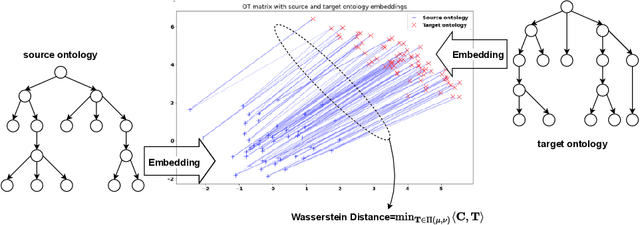



Abstract:Measuring the distance between ontological elements is a fundamental component for any matching solutions. String-based distance metrics relying on discrete symbol operations are notorious for shallow syntactic matching. In this study, we explore Wasserstein distance metric across ontology concept embeddings. Wasserstein distance metric targets continuous space that can incorporate linguistic, structural, and logical information. In our exploratory study, we use a pre-trained word embeddings system, fasttext, to embed ontology element labels. We examine the effectiveness of Wasserstein distance for measuring similarity between (blocks of) ontolgoies, discovering matchings between individual elements, and refining matchings incorporating contextual information. Our experiments with the OAEI conference track and MSE benchmarks achieve competitive results compared to the leading systems such as AML and LogMap. Results indicate a promising trajectory for the application of optimal transport and Wasserstein distance to improve embedding-based unsupervised ontology matchings.
Building Open Knowledge Graph for Metal-Organic Frameworks (MOF-KG): Challenges and Case Studies
Jul 10, 2022



Abstract:Metal-Organic Frameworks (MOFs) are a class of modular, porous crystalline materials that have great potential to revolutionize applications such as gas storage, molecular separations, chemical sensing, catalysis, and drug delivery. The Cambridge Structural Database (CSD) reports 10,636 synthesized MOF crystals which in addition contains ca. 114,373 MOF-like structures. The sheer number of synthesized (plus potentially synthesizable) MOF structures requires researchers pursue computational techniques to screen and isolate MOF candidates. In this demo paper, we describe our effort on leveraging knowledge graph methods to facilitate MOF prediction, discovery, and synthesis. We present challenges and case studies about (1) construction of a MOF knowledge graph (MOF-KG) from structured and unstructured sources and (2) leveraging the MOF-KG for discovery of new or missing knowledge.
Clustering and Network Analysis for the Embedding Spaces of Sentences and Sub-Sentences
Oct 02, 2021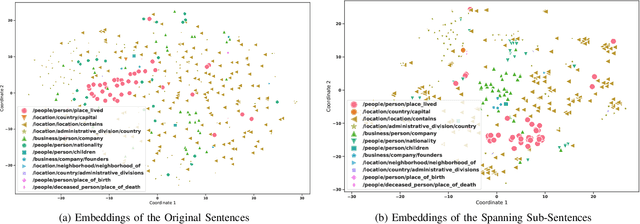
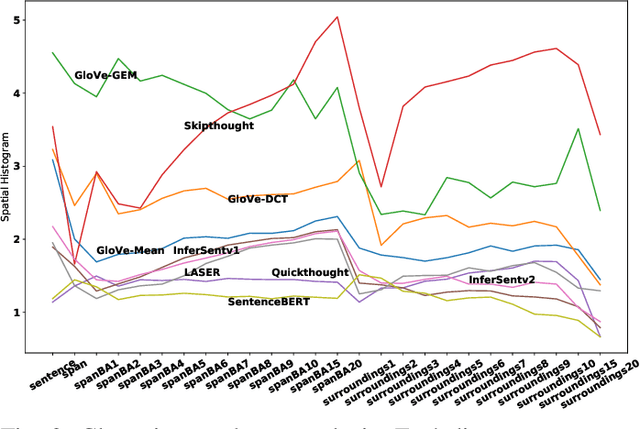

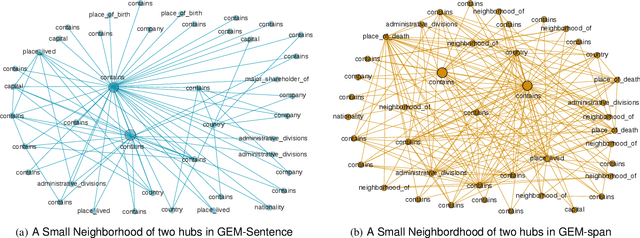
Abstract:Sentence embedding methods offer a powerful approach for working with short textual constructs or sequences of words. By representing sentences as dense numerical vectors, many natural language processing (NLP) applications have improved their performance. However, relatively little is understood about the latent structure of sentence embeddings. Specifically, research has not addressed whether the length and structure of sentences impact the sentence embedding space and topology. This paper reports research on a set of comprehensive clustering and network analyses targeting sentence and sub-sentence embedding spaces. Results show that one method generates the most clusterable embeddings. In general, the embeddings of span sub-sentences have better clustering properties than the original sentences. The results have implications for future sentence embedding models and applications.
A Survey of Embedding Space Alignment Methods for Language and Knowledge Graphs
Oct 26, 2020
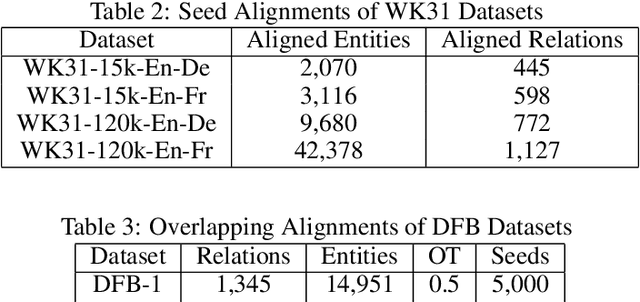

Abstract:Neural embedding approaches have become a staple in the fields of computer vision, natural language processing, and more recently, graph analytics. Given the pervasive nature of these algorithms, the natural question becomes how to exploit the embedding spaces to map, or align, embeddings of different data sources. To this end, we survey the current research landscape on word, sentence and knowledge graph embedding algorithms. We provide a classification of the relevant alignment techniques and discuss benchmark datasets used in this field of research. By gathering these diverse approaches into a singular survey, we hope to further motivate research into alignment of embedding spaces of varied data types and sources.
A Comparative Study on Structural and Semantic Properties of Sentence Embeddings
Sep 23, 2020



Abstract:Sentence embeddings encode natural language sentences as low-dimensional dense vectors. A great deal of effort has been put into using sentence embeddings to improve several important natural language processing tasks. Relation extraction is such an NLP task that aims at identifying structured relations defined in a knowledge base from unstructured text. A promising and more efficient approach would be to embed both the text and structured knowledge in low-dimensional spaces and discover semantic alignments or mappings between them. Although a number of techniques have been proposed in the literature for embedding both sentences and knowledge graphs, little is known about the structural and semantic properties of these embedding spaces in terms of relation extraction. In this paper, we investigate the aforementioned properties by evaluating the extent to which sentences carrying similar senses are embedded in close proximity sub-spaces, and if we can exploit that structure to align sentences to a knowledge graph. We propose a set of experiments using a widely-used large-scale data set for relation extraction and focusing on a set of key sentence embedding methods. We additionally provide the code for reproducing these experiments at https://github.com/akalino/semantic-structural-sentences. These embedding methods cover a wide variety of techniques ranging from simple word embedding combination to transformer-based BERT-style model. Our experimental results show that different embedding spaces have different degrees of strength for the structural and semantic properties. These results provide useful information for developing embedding-based relation extraction methods.
 Add to Chrome
Add to Chrome Add to Firefox
Add to Firefox Add to Edge
Add to Edge